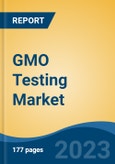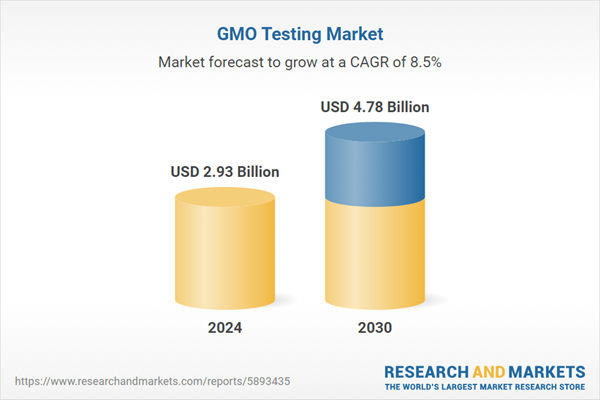Speak directly to the analyst to clarify any post sales queries you may have.
10% Free customizationThis report comes with 10% free customization, enabling you to add data that meets your specific business needs.
Through testing, it becomes possible to identify the presence of genetic modification in a product, as well as the specific type of modification, providing crucial information for consumers and regulators alike. GMO testing can be conducted at various stages of the product lifecycle, encompassing the development and cultivation of GMO crops, as well as the production and distribution of GMO-derived products. This testing extends to a wide range of items, including food, animal feed, seeds, and plant materials.
The growing consumer demand for transparency and clean-label products is one of the key factors fueling the expansion of the global GMO testing market. As public awareness regarding the health, environmental, and ethical concerns associated with genetically modified organisms increases, regulatory bodies across various regions have introduced stringent labeling laws and safety standards. In regions like Europe, mandatory GMO labeling has driven a surge in testing activities across the food supply chain. Even in countries where GMO labeling is voluntary, food manufacturers are investing in testing to cater to the rising demand for non-GMO verified products and to strengthen brand trust among health-conscious consumers.
Key Market Drivers
Growing Demand for Genetically Modified Foods
Consumers are increasingly demanding transparency about genetically modified ingredients, pushing food manufacturers to prioritize GMO testing. Recent data reveals that nearly 86% of informed consumers want clear labeling for GMO-containing foods, reflecting a strong preference for informed food choices. Additionally, with over 60 countries implementing GMO labeling regulations, companies are investing in rigorous testing protocols to ensure accurate labeling and compliance. As GMOs are integrated into food production at various stages from seeds to final packaging - businesses rely on GMO testing to confirm ingredient integrity and meet growing expectations for safety and transparency.The widespread cultivation of genetically modified crops is further driving the need for consistent testing. As of the latest estimates, more than 200 million hectares of GM crops are being cultivated globally, with adoption rates as high as 76% for GM cotton and 72% for GM soybeans. These figures underscore the scale at which GM technology is being adopted. As a result, testing has become essential across the supply chain to verify the presence or absence of GM traits in seeds, raw materials, and finished products especially in markets that require strict GMO segregation or have low tolerance thresholds.
GMO testing also plays a vital role in addressing regulatory concerns and ensuring product safety. Despite approval by regulatory authorities, ongoing surveillance is necessary to detect unintended gene expressions or unauthorized traits. Some regions enforce labeling thresholds as low as 0.9%, requiring precise identification and quantification of GMO content. Through continuous testing, manufacturers can trace ingredient origins and segregate GMO from non-GMO materials, reducing the risk of cross-contamination and ensuring compliance with domestic and international standards.
Moreover, the rising demand for genetically engineered foods with enhanced nutritional value, pest resistance, and climate adaptability is expanding the GMO footprint globally. This trend is especially strong in developing nations that rely on biotech crops to improve food security. As production increases, so does the need for scalable, sensitive testing solutions like PCR, ELISA, and DNA sequencing. These technologies enable early-stage detection, ensure accurate labeling, and support certification for non-GMO claims thereby fueling the overall growth of the GMO testing market.
Key Market Challenges
Ban On the Production of GM Crops in Some Regions
The ban on the production of genetically modified (GM) crops in some regions can hinder the growth of GMO testing. When GM crop cultivation is prohibited or restricted in a certain area, the demand for GMO testing may be reduced due to limited or no presence of genetically modified ingredients. In regions where GM crop cultivation is banned, there will be a limited supply of genetically modified ingredients in the local food market. This limitation reduces the need for GMO testing since there are fewer opportunities for genetically modified ingredients to be present in processed foods.When GM crop cultivation is banned, consumers in those regions might have limited exposure to genetically modified foods, leading to lower awareness and concerns about their presence. As a result, the demand for GMO testing may be lower due to decreased consumer interest in knowing whether foods contain GM ingredients. Bans on GM crop production can lead to fragmented markets where some regions allow GM crops while others do not. This fragmentation can complicate supply chains and make it less economically viable for manufacturers to conduct GMO testing for smaller markets with bans. If GM crop production is prohibited in certain regions, the costs associated with GMO testing might not be justified for food manufacturers operating within those regions. This could impact the adoption of GMO testing practices.
Key Market Trends
Emerging Markets for GMO Testing
Many countries are implementing or strengthening regulations regarding the labeling of genetically modified ingredients. This regulatory push encourages food manufacturers to invest in GMO testing to comply with these requirements and provide accurate information to consumers. The global trade of food products necessitates consistent standards for GMO testing to ensure products meet the regulations of importing countries. Emerging markets for GMO testing can help facilitate smoother international trade by providing reliable testing services that adhere to international guidelines.As biotechnology continues to advance, new genetically modified crop varieties and traits are being developed. Emerging markets for GMO testing will need to keep up with these advancements to accurately detect and analyze the latest modifications. As awareness of GMOs spreads to new regions, the demand for GMO testing services is likely to follow suit. This could be driven by factors such as changes in dietary habits, regulatory updates, and global trade patterns.
Key Market Players
- EnviroLogix Inc.
- Microbac Laboratories, Inc.
- TUV SUD AG
- R-Biopharm AG
- Institut Merieux, ALS Limited
- OMIC USA Inc.
- Eurofins Scientific
- Premier Foods plc
- Thermo Fisher Scientific Inc.
- Bio-Rad Laboratories, Inc.
Report Scope:
In this report, the Global GMO Testing Market has been segmented into the following categories, in addition to the industry trends which have also been detailed below:GMO Testing Market, By Technology:
- Polymerase Chain Reaction
- ELISA Test
- Strip Test
GMO Testing Market, By Crop Type:
- Corn
- Soy
- Rapeseed & Canola
- Potato
- Others
GMO Testing Market, By Trait:
- Stacked
- Herbicide Tolerance
- Insect Resistance
GMO Testing Market, By Region:
- North America
- United States
- Canada
- Mexico
- Europe
- France
- United Kingdom
- Italy
- Germany
- Spain
- Asia-Pacific
- China
- India
- Japan
- Australia
- South Korea
- South America
- Brazil
- Argentina
- Colombia
- Middle East & Africa
- South Africa
- Saudi Arabia
- UAE
Competitive Landscape
Company Profiles: Detailed analysis of the major companies present in the Global GMO Testing Market.Available Customizations:
With the given market data, the publisher offers customizations according to a company's specific needs. The following customization options are available for the report.Company Information
- Detailed analysis and profiling of additional market players (up to five).
Table of Contents
Companies Mentioned
- EnviroLogix Inc.
- Microbac Laboratories, Inc.
- TUV SUD AG
- R-Biopharm AG
- Institut Merieux, ALS Limited
- OMIC USA Inc.
- Eurofins Scientific
- Premier Foods plc
- Thermo Fisher Scientific Inc.
- Bio-Rad Laboratories, Inc.
Table Information
| Report Attribute | Details |
|---|---|
| No. of Pages | 188 |
| Published | August 2025 |
| Forecast Period | 2024 - 2030 |
| Estimated Market Value ( USD | $ 2.93 Billion |
| Forecasted Market Value ( USD | $ 4.78 Billion |
| Compound Annual Growth Rate | 8.4% |
| Regions Covered | Global |
| No. of Companies Mentioned | 10 |









